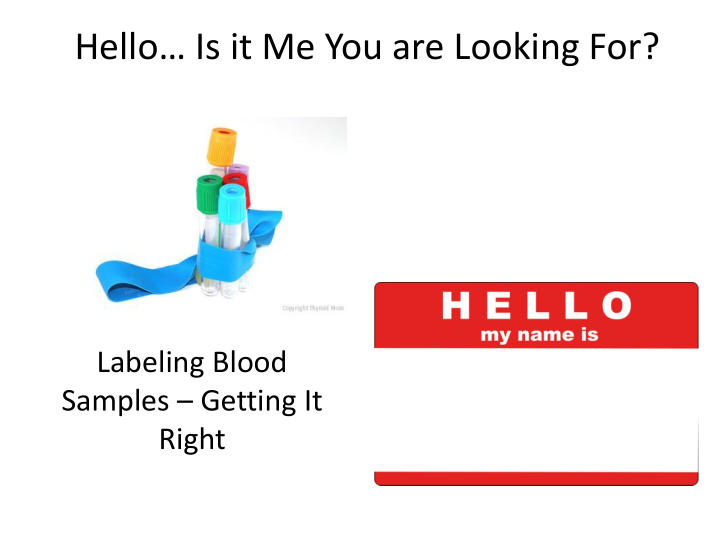



Hello… Is it Me You are Looking For? Labeling Blood Samples – Getting It Right
Labeling Blood Samples There are documented occurrences and near misses of mislabeling of blood samples (for example type and screen) = Potential for serious harm to the patient!
The Process Manitoba Transfusion Medicine Best Practice Resource Manual for Nursing: “There shall be unequivocal identification of the intended recipient before drawing blood specimens using the patient armband or Provincial Health Card. Includes: The patient’s last and first name Personal Health Identification Number (PHIN) or Unique identifier , if there is no PHIN”
The Process Blood specimens shall be labeled in the patient’s presence Label includes name, PHIN (or unique identifier) and date of collection Label must be attached to the specimen tube before leaving patient’s side Request form is prepared with correct patient identifiers Perform final check that specimen, requisition and patient’s armband are all identical
How does mislabeling occur? When a blood sample is drawn from the patient… The main issue appears to be 1 of 2 scenarios:
Scenario #1 • A pre-labeled specimen tube with another patient’s information is used to collect blood. • The patient information is not reconciled at the bedside with the patient’s identification on their armband. • As a result, the patient info on the blood sample may not match the patient who actually had their blood drawn.
Scenario #2 • An unlabeled specimen tube is used to collect blood. • The unlabeled specimen tube is taken out of the room, and then the specimen is labeled with a different patient’s information. • As a result, the patient info on the blood sample will not match the patient who actually had their blood drawn.
How is mislabeling discovered? • By the unit • By the lab • By CBS
Reported Events 2014 Data: Incidents reported related to • mislabeling of specimens or requisitions • or wrong patient blood draw HSC: SBGH: 45 Occurrences 18 Occurrences 13 Near Misses 0 Near Misses
Occurrence #1 • Blood work drawn on patient in bed 10. Unlabeled tube handed to unit clerk and told it was bed 10’s blood work. • Blood tubes mistakenly labeled with Bed 5’s addressograph and submitted. Error noted when the nurse of Bed 5 received blood work results and knew that no blood work was ordered for that patient. • Blood work had to be redrawn on patient in Bed 10.
Occurrence #2 • CBS received a type and screen sample for a patient. (Jane Smith) The sample was O positive. • Their previous records stated that Jane Smith was A positive. • CBS contacted the ward and it was confirmed that the blood sample was taken from another patient and mistakenly stamped with Jane Smith’s information. • If there had not been a previous blood group on file, it could have resulted in a fatality in the event this patient was transfused. • Also resulted in a delay for the other patient who required the type and screen to receive a life-saving blood transfusion.
Occurrence #3 • Post partum patient required urgent Type and Screen for emergent OR • An unlabeled tube was used so the step to verify the label to the patient’s armband was not done. • Another nurse assisted with labeling and sending the specimen due to the urgency of getting to the OR. • The wrong addressograph was used to label the sample and requisition. • Incident was discovered by the unit and communicated to Blood Bank who let CBS know to stop report.
Occurrence #4 • A verbal request for group and match for transfusion received by phlebotomist for Patient A • Proceeded to multi-patient area (day procedure) to locate patient identified as sitting in 3 rd chair {Patient B sitting in this chair} • Group and match drawn and brought to main desk for labeling from requisition • Requisition correctly made for Patient A requiring transfusion • Sample labeled with Patient A • Cross match blood arrived, checked and administered • Transfusion reaction occurred • Post transfusion reaction protocol discovered original A+ match was not same as post reaction sample of O+ • Fortunately Patient A had precautionary antihistamine treatment secondary to the medication he was receiving so the effect of the wrong blood was mitigated – however he did require a 32 hour stay in hospital
Patient Safety Impact of mislabeled Type & Screen Infrequent event but has potential to cause significant harm • Redraw of Type & Screen • Delay in blood transfusion • Increase in the use of Emergency Blood • Wrong blood type transfused in a patient with increase in morbidity and mortality o can cause acute hemolysis due to ABO incompatibility
Impact on Resources & Workload For the Blood Bank lab: Notification of unit, CBS etc Work associated with reprocessing an additional T&S specimen (accessioning, packaging, shipping to CBS etc) Documentation of rejected specimen, initiate NCR
Impact on Resources & Workload For the Unit Notification of lab, physician, patient, follow up with staff involved Work associated with recollection of a new specimen& requisition on correct patient Documentation in patient record, initiation of an Occurrence Report
Impact on Resources & Workload For CBS Notification of lab, Medical Director communicates with clinical area via letter Work associated with investigation of descrenpant results, processing a new specimen& requisition on correct patient Documentation re rejected specimen, initiation of an NCR
Solutions Review your process Compare to Blood specimens shall be labeled in the patient’s presence Label includes name, PHIN (or unique identifier) and date of collection Label must be attached to the specimen tube before leaving patient’s side Request form is prepared with correct patient identifiers Perform final check that specimen, requisition and patient’s armband are all identical Identify the Gaps – Commit to Action
Discussion and Questions
Recommend
More recommend